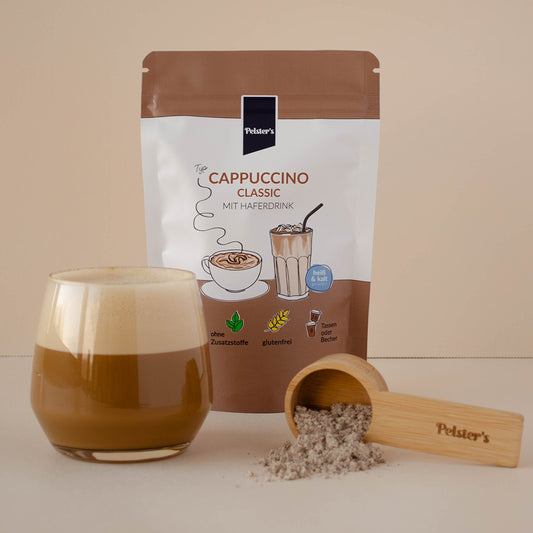Chai tea has been a popular drink for years, and the "Chai Latte" in particular has become a real gourmet trend. Traditionally, Chai Latte was made with cow's milk, but with the rise of vegan diets, we at Pelster's have created a new variant: our instant chai tea with oat drink . In order to offer you the best not only in terms of taste, but also in terms of content, we have examined the roots of Chai in more detail and researched its health benefits for you.
The Origin of Chai
The term "Chai" is derived from the northern Chinese "ch'a" and simply means tea. The drink originally comes from northern China, but its current form, which we know as Chai, was largely shaped in India. There it is known as "Masala Chai", which means "spiced tea" in Hindi - an apt name that perfectly captures the essence of this popular drink.(1)
Traditionally, chai consists of black tea combined with milk, honey or brown sugar and a carefully balanced mixture of spices such as cardamom, ginger, cinnamon, cloves, fennel, anise and pepper. This combination of spices comes from Ayurvedic teachings, which emphasize that medicinal plants have a beneficial effect on both the body and the soul. Therefore, chai is said to have positive effects on well-being thanks to its spices.(1)
In India, chai is an integral part of everyday life. You can find it on every street corner, in every café and in households, often accompanied by sweet pastries or salted nuts. Today, chai is not only available in the classic version with black tea, but also in variations with green tea or rooibos tea.(1)
The Health Benefits of Chai
But chai is more than just a taste sensation. Thanks to the beneficial properties of its ingredients, it also helps promote health.
Black Tea - The Soul of Chai:
The basis of a traditional chai is black tea, which is made from the leaves of Camellia sinensis L. This tea accounts for an impressive 78% of global tea production and is the heart of chai. (11)
Black tea is rich in important compounds such as flavonoids, phenolic acids, alkaloids and polyamines. Flavonoids and phenolic acids in particular support the immune system and promote heart health. The alkaloid contained in tea, caffeine, has an invigorating effect, but is gentler than the caffeine in coffee. Polyamines play a crucial role in cell growth and division, which is of great importance for tissue regeneration. (1,11,12)
Another valuable component of black tea is theaflavin. It not only contributes to the bright orange color of the infusion, but also helps to lower cholesterol levels and protects against cardiovascular disease, cancer and high blood pressure. (12,13)
Ginger – The anti-inflammatory superstar:
Ginger is one of the signature spices in Masala Chai and is valued for its anti-inflammatory, antispasmodic and immune-boosting properties. (1,7)
Ginger is particularly effective in relieving nausea, whether during pregnancy or after surgery. It has a calming effect on the gastrointestinal system and supports the central nervous system. In addition, ginger can help with colds, fever and digestive problems and also serves as a natural appetite stimulant. (7)
Cardamom – The aromatic remedy:
Cardamom not only gives chai its characteristic aroma, but also aids digestion (1) and is used in traditional medicine for various ailments such as asthma, gingivitis, nausea, diarrhea, heart, digestive and kidney diseases. (6)
Cinnamon – The sweet health booster:
Cinnamon has played a significant role in traditional Chinese and Indian medicine for centuries, where it has been used successfully to treat a variety of ailments, including flatulence, amenorrhea, diarrhea, toothache, fever, leukorrhea, colds, and headaches. Scientific studies support these traditional uses and confirm the diverse health benefits of cinnamon. (5)
This aromatic spice is characterized by its anti-inflammatory, antimicrobial and antioxidant properties. In addition, cinnamon can effectively lower cholesterol and blood pressure, as well as exert a protective effect on the stomach. Particularly noteworthy is its ability to enhance insulin activity and stimulate cellular glucose metabolism, making it a valuable ingredient for a healthy diet. (4,5)
Carnations – The little powerhouses:
Cloves are not only known as a natural food preservative, but are also valued for their versatile medicinal uses. They are one of the richest sources of phenolic compounds, especially the valuable eugenol. (8)
Compared to many fruits, vegetables and other spices, cloves are characterized by their exceptionally high antioxidant and antimicrobial activity, making them a powerful natural remedy. (8)
Pepper – The spicy ally:
Pepper is an essential spice in Masala Chai, appreciated not only for its spiciness but also for its health benefits. The main active ingredient piperine plays a central role: it stimulates the digestive enzymes of the pancreas, increases digestive efficiency and shortens the time that food takes to pass through the gastrointestinal tract. In addition, piperine protects the body from oxidative damage by neutralizing free radicals. (9)
Another notable effect of piperine is its ability to influence biomembranes and promote the absorption of various nutrients and active ingredients. (10)
Real spice power
Each individual spice in Masala Chai already brings numerous health benefits. But the real power comes when they work together and enhance each other's individual effects. (1)
Particularly noteworthy is the strong antioxidant effect of these spices, led by cloves, followed by cinnamon, pepper and ginger. These valuable properties are retained even when stored at 100 °C for 30 minutes, so they are still active in the hot chai drink. (2)
Together, the spices not only promote digestion, but also protect against cell damage and support the absorption and utilization of fats, proteins and carbohydrates. (2,3)
Conclusion
Chai latte is more than just a delicious drink. It is a source of numerous health benefits thanks to its diverse spices. From supporting the immune system to improving digestion to fighting inflammation, the ingredients in Masala Chai help to promote our well-being. With Pelster's Chai Tea with Oat Drink, you can enjoy these health benefits while experiencing quick and easy preparation. So you can pamper your taste buds and do something good for your body at the same time in just a few minutes!
Sources
(1) VerbraucherService Bayern. (2019). Nutrition – Chai tea. Online at: https://www.verbraucherservice-bayern.de/themen/ernaehrung/chai-tee (last accessed: August 26, 2024).
(2) Shobana, S., & Naidu, K.A. (2000). Antioxidant activity of selected Indian spices. Prostaglandins, Leukotrienes and Essential Fatty Acids (PLEFA) , 62 (2), 107-110.
(3) Platel, K., & Srinivasan, K. (2004). Digestive stimulant action of spices: a myth or reality?. Indian Journal of Medical Research , 119 (5), 167.
(4) Gruenwald, J., Freder, J., & Armbruester, N. (2010). Cinnamon and health. Critical reviews in food science and nutrition , 50 (9), 822-834.
(5) Hajimonfarednejad, M., Ostovar, M., Raee, MJ, Hashempur, MH, Mayer, JG, & Heydari, M. (2019). Cinnamon: A systematic review of adverse events. Clinical Nutrition , 38 (2), 594-602.
(6) Ashokkumar, K., Murugan, M., Dhanya, MK, & Warkentin, TD (2020). Botany, traditional uses, phytochemistry and biological activities of cardamom [Elettaria cardamomum (L.) Maton]–A critical review. Journal of ethnopharmacology , 246 , 112244.
(7) White, B. (2007). Ginger: an overview. American family physician , 75 (11), 1689-1691.
(8) Cortés-Rojas, DF, de Souza, CRF, & Oliveira, WP (2014). Clove (Syzygium aromaticum): a precious spice. Asian Pacific journal of tropical biomedicine , 4 (2), 90-96.
(9) Srinivasan, K. (2007). Black pepper and its pungent principle-piperine: a review of various physiological effects. Critical reviews in food science and nutrition , 47 (8), 735-748.
(10) Ahmad, N., Fazal, H., Abbasi, BH, Farooq, S., Ali, M., & Khan, MA (2012). Biological role of Piper nigrum L.(Black pepper): A review. Asian Pacific Journal of Tropical Biomedicine , 2 (3), S1945-S1953.
(11) da Silva Pinto, M. (2013). Tea: A new perspective on health benefits. Food research international , 53 (2), 558-567.
(12) Cooper, R., Morré, DJ, & Morré, DM (2005). Medicinal benefits of green tea: Part I. Review of noncancer health benefits. Journal of Alternative & Complementary Medicine , 11 (3), 521-528.


























